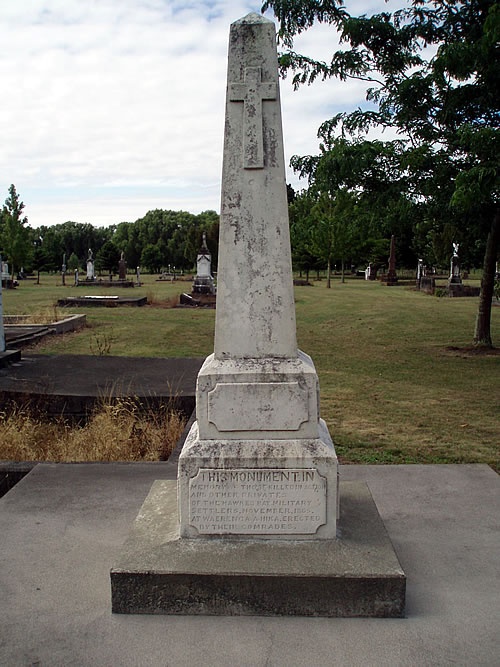
Little is currently known about the erection of this memorial. It stands in Makaraka Cemetery on State Highway 2, about 5 km north-west of the centre of the East Coast city of Gisborne. The memorial records the names of six Hawke’s Bay Military Settlers who died on 18 November 1865 during the siege of Waerenga-a-Hika pā.
In spring 1865, several hundred followers of the Pai Mārire religion from Poverty Bay’s Rongowhakaata and Te Aitanga-a-Māhaki iwi built a strongly fortified pā at Waerenga-a-Hika, 10 km inland from Gisborne (then known as Tūranganui).
On 16 November, a force of about 300 Māori, mostly Ngāti Porou who opposed Pai Mārire, and up to 200 Europeans (including Military Settlers under Lieutenant James Wilson) laid siege to Waerenga-a-Hika. The operation lasted six days.
After two days, the colonial force attempted to set up an advanced post close to the pā. Wilson and 30 Military Settlers were sent to begin digging a sap (covered trench) towards the pā. In this vulnerable position, they were attacked by a large body of enemy reinforcements. Under heavy fire from both outside and inside the pā, they charged with fixed bayonets back towards the main colonial force. In this dash, six colonists were killed and five wounded.
Official casualty lists confirm that Sergeants William Doonan and Robert Martin and Private James Wilkie died at Waerenga-a-Hika on 18 November. It is almost certain that these men died in this desperate retreat. The same casualty lists show that Private Robert Bothwell and Lance-Corporal William Pierson, also of the Hawke’s Bay Military Settlers, also died at Waerenga-a-Hika that day. The discrepancies between the lists and the memorial may result from incorrect spelling, transcription error or mistaken identity.
The casualty lists do not mention a Military Settler named William Swords dying at Waerenga-a-Hika. The lists are not comprehensive and Swords may nevertheless have died in this battle.
All six men were initially buried on the battle site. In his history of the New Zealand Wars, James Cowan provides a map of Waerenga-a-Hika pa and the battle site which shows the location of Doonan’s grave. It is thought that Martin, Wilkie, Bothwell, Pierson and Swords were later exhumed and reinterred in Makaraka Cemetery.
After suffering heavy casualties, about 400 of the Waerenga-a-Hika defenders surrendered on 22 November. The attacking force had lost 11 killed and 20 wounded.
Among the Māori who participated in the siege of Waerenga-a-Hika on the government side was Te Kooti Arikirangi Te Tūruki of Rongowhakaata. But he was accused of collaborating with the Pai Mārire forces, and a little over a year later joined them in exile on the Chatham Islands. By the end of 1867, Te Kooti was the recognised leader of these men. One of the most notable Waerenga-a-Hika prisoners, Eru Peka Makarini (Edward Baker McLean), would become Te Kooti’s ‘best fighting man’.
Images
Inscription
Front face:
This monument in / memory of those killed in action / and other privates / of the Hawke’s Bay Military / Settlers. November 1865 / at Waerenga-a-hika. Erected / by their comrades.
Face [B]:
In Memory of / William Doonan / Sergeant R. Martin / James Wilkie.
Face [C]:
Also of / David Borthwick / William Swords / E. Pierson
[Fourth face is blank]
Further information
- James Belich, ‘A new kind of war’, in The New Zealand Wars and the Victorian interpretation of racial conflict, Penguin, Auckland, 1998, pp. 203–34
- James Cowan, ‘The Siege of Waerenga-a-Hika’, in The New Zealand Wars: a history of the Maori campaigns and the pioneering period: volume II: The Hauhau Wars, 1864–72, R.E. Owen, Wellington, 1956, pp. 124–8
- Nigel Prickett, ‘The East Coast, 1865–66’, in Landscapes of conflict: a field guide to the New Zealand Wars, Random House, Auckland, 2002, pp. 125–31




Community contributions